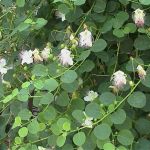| Common Name: |
Caper |
| Botanical Name: |
Capparis spinosa |
| Genus: |
Capparis |
| Family: |
Capparidaceae |
| Cultivation: |
Well-drained, sandy soil in sun. |
| Propagation: |
By seed sown in autumn or spring; by ripewood cuttings in summer at 19-24°C (66-75°F). Germination is slow and erratic, taking an average 5 to 7 weeks, sometimes up to a year. |
| Harvest: |
Flower buds are picked in early morning and wilted before salting or pickling in salted white vinegar. Leaves and immature fruits are also picked. Bark is stripped from roots lifted in autumn, and then dried. |
| Native Location: |
Tropical and Subtropical regions worldwide |
| Height: |
1m (3ft) |
| Width: |
1.5m (5ft) |
| Variations: |
Var. inermis
Lacks spines.
Pantelleria
Produces large, flavorful capers. |
| Hardiness: |
Z9 |
| Parts Used: |
Root bark, flower buds, fruits ("caperberries") |
| Properties: |
An astringent, diuretic, expectorant herb that is regarded as a stimulating tonic. |
| Medicinal Uses: |
Internally for gastrointestinal infections, diarrhea, skin problems, fragile capillaries, internal bleeding, gout, rheumatism (root bark); for coughs (flower buds). Externally for eye infections, (flower buds). |
| Culinary Uses: |
Pickled or dry-salted caper buds are used in caper sauce for lamb, tartare, ravigote, remoulade, and puttanesca sauces, fish dishes, and hors d'oeuvres, especially caponata. Caperberries are used similarly, and to accompany smoked salmon. |
| Bibliography: |
Encyclopedia of Herbs by Deni Brown. Copyright © 1995, 2001 Dorling Kindersley Limited. pg 153
|
